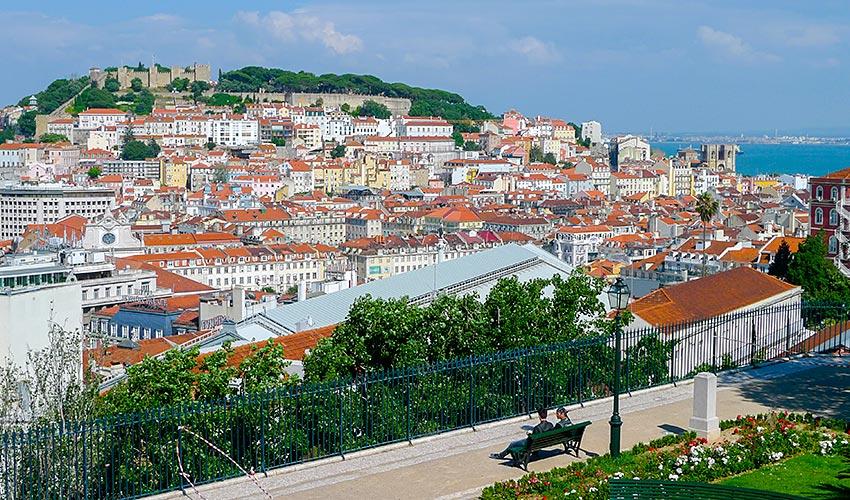Lisbon is so many special things; it’s the sound of vintage trams rambling up and down cobblestone streets, a medley of heartfelt Fado songs, an open-air gallery of historic heritage, a haven for free spirits, a surprise for fashionable shoppers and Portugal’s ‘coolest’ city.
According to legend, the city of Lisbon was originally built on seven hills and stretches out along the Tagus River in an undulating landscape of maze-like paths, clusters of Art Nouveau buildings, magnificent landmarks, countless museums, fabulous hotels, scattered café terraces and magnificent viewpoints.
Steeped in history and culture, this enchanting ‘city of light’ boasts a natural luminosity and effortless charm unlike any other in the country and has become a popular European destination for its exciting diversity, beautiful sites and enviable, sunny climate. Marking every spot in the city with a touch of tradition, Lisbon is all about preserving the beauty of ‘old’, whether embodied by friendly flower sellers and chestnut vendors on the streets, its majestic azulejo adorned architecture and typical pastry shops or charming, tavern-inspired restaurants. As the capital city, Lisbon chronicles some of the most influential chapters in Portuguese history including over 400 years of Moorish occupation, a flourishing seafaring age, the end of an 800 year-old monarchy, the rise of a dictatorship and a peaceful revolution.
If there’s a part of this multifaceted city that has seen it all, it’s Lisbon’s city centre – the Baixa. After the Great Earthquake of 1755, this historic centre was successfully rebuilt due to the effort and persistence of Portuguese Prime Minister, Marquis de Pombal and is still considered one of the most impressive examples of architectural reconstruction in Europe for its advanced materials and techniques. The oldest part of this scenic location is Rossio, known for its street shoe-shiners, historic theatres and mix of restaurants and coffee shops. Wander through the dynamic Augusta Street to reach the stunning Praça do Comércio – one of Europe’s most distinguished squares and home to Lisbon’s oldest cafés – and enjoy the surrounding shops, open-air stalls and street performers that liven up the area. Also be sure to taste the country’s famous sweet cherry liquor at Rossio’s minuscule ‘Ginjinha’ tavern and to ride up the Santa Justa Lift to contemplate Lisbon from above.
Leading to the bustling Marquês de Pombal roundabout and its magnificent Eduardo VII Park (named after King Edward VII following his visit in 1902), is the elegant, tree-lined Avenida da Liberdade Lisbon’s most glamorous avenue and famous for its sophisticated shopping opportunities, ritzy restaurants and luxurious hotels.
The heart of urban glamour and style can be found in Chiado, especially cosmopolitan spot where ‘old and new’ go harmoniously hand-in-hand. Characterised by its casual-chic atmosphere, string of shops, fashionable eateries, picturesque black-and-white cobblestone streets, beautiful churches and timeless coffee shops, Chiado will have you feeling like a ‘Lisboeta’ in no time. Be sure to try Lisbon’s typical ‘bica’ (expresso coffee) at the famous ‘A Brasileira’ café during your visit – once a meeting point for 19th Century intellectuals such as acclaimed poet and writer, Fernando Pessoa.
In contrast to Chiado’s sunlit charm, the ‘arty’ district of Bairro Alto is home to Lisbon’s bohemian nightlife and alternative lifestyle. Composed of criss-crossing paths dotted with traditional low-rise houses with quaint verandas and dangling clothes-lines, this apparently old-fashioned neighbourhood turns into the hottest spot in Lisbon in the evening and fills up with crowds of night owls who enjoy spontaneous bar-hopping, an eclectic selection of music and great little restaurants. Although Lisbon offers a rich nightlife, the internationally renowned LUX club in Santa Apolónia has become a landmark in its own right, known for its trendy waterfront location and pumping music – partly owned by North-American actor John Malkovich.
Unveil the former Moorish neighbourhood of Alfama, the oldest district in the city. Retaining its picturesque charm and historic essence, Alfama is a common favourite with travellers for its Arab-inspired networks of winding streets, whitewashed houses and typical Fado taverns. Nearby, you can visit the wonderful ‘Museu do Fado’ and ‘Museu do Azulejo’ (fado and tile museums), as well as the striking São Jorge Castle. Every year, Alfama and the nearby Mouraria neighbourhood attract enthusiastic crowds of all generations during Lisbon’s vibrant ‘Santos Populares’ festival, an exciting folk celebration that dresses the entire city in colourful streamers and open-air stalls, livens the atmosphere with cheerful marching troupes, joyful music and bustling restaurants where refreshing jugs of fruity sangria can be enjoyed along with a batch of sizzling sardines served right off the grill.
Near the ‘25 de Abril’ Bridge lies the beautiful, waterfront district of Belém. Enriching the area with majestic symbols of Portugal’s glorious seafaring past and heroes, this serene part of the city is idyllic for history-lovers and home to iconic landmarks such as the Jerónimos Monastery, Monument to the Discoveries and the Belém Tower. Belém is also home to an acclaimed cultural centre, a modern art gallery, museums and a planetarium, as well as to Belém’s indescribably delicious custard tarts!
Also evoking Lisbon’s maritime legacy is the innovative, cutting-edge commercial and residential Parque das Nações area. Situated in the opposite direction to Belém, this futuristic, eye-catching part of Lisbon is known for hosting a variety of prestigious national and international events and is popular for its enormous shopping centre, outdoor eateries, bars, casino and Oceanarium – one of the most high-tech in Europe.
Places to See
Historical Sites
Torre de Belém (Belém Tower)
Rising out of the Tagus River, this magnificent tower is one of the greatest symbols of Portugal’s Age of Discovery. Commissioned by King João II and designed by architect Francisco de Arruda, this 16th Century tower was primarily built to defend the Lisbon harbour, as well as to create a striking gateway to the city. Meticulously sculpted battlements, elegant limestone turrets and a hexagon-shaped bastion are features that embellish this unique landmark. Nevertheless, the tower’s main highlight is its stone-sculpted rhinoceros – the first ever to be made in Europe.
Mosteiro de Jerónimos (Jerónimos Monastery)
This stunning UNESCO World Heritage Site will sweep you away with its majestic display of Manueline opulence. Portraying the wealth of the crown, as well as the creative vision of King Manuel I and architect Diogo de Boitaca, this 300 metre-long monument is one of the most impressive examples of religious architecture in the world. Composed of two-storey cloisters, exuberant Gothic features, ribbed vaults and intricate floral motifs, this prominent monastery also holds the tombs of historical figures such as King Manuel I, explorer Vasco da Gama and writers/poets Luís de Camões and Fernando Pessoa.
Popular spots
Pastéis de Belém (Belém Custard Tarts)
If Lisbon had a flavour, it would definitely be the sweet, creamy taste of Belém’s divine custard tarts. Visit the traditional Pastéis de Belém coffee shop near the Jerónimos Monastery and order a box of these delicious cinnamon and sugar sprinkled pastries. Made with a secret recipe that has yet to be unveiled, you’ll find that a touch of mystery will make these unparalleled specialities taste even better!
Miradouros de Lisboa (Lisbon viewpoints)
Lisbon is blessed with amazing scenery and can be enjoyed from different perspectives – literally! Providing a relaxed atmosphere, café terraces and stunning views of the city, Lisbon’s viewpoints are excellent spots to admire fiery sunsets and views of the Tagus. Some of the most popular are the São Pedro de Alcântara, Santa Catarina and São Jorge Castle viewpoints.
Museu Calouste Gulbenkian (Calouste Gulbenkian Museum)
Founded by Armenian philanthropist Calouste Gulbenkian in 1968, this amazing museum is one of the most prestigious cultural venues in the country. Containing a collection of ancient and modern art from all around the globe, this museum displays permanent and temporary exhibitions of different art works ranging from ancient Egyptian and Roman artefacts to a lovely collection of 20th Century European paintings.
Aquário Vasco da Gama
Aquário Vasco da Gama, which is over one hundred years old, is situated in Oeiras and falls under the supervision of the Portuguese Navy. It has five rooms with around 90 aquariums and tanks containing more than 300 live freshwater, brackish water and salt water marine species from both the Northern and Southern hemispheres, although there are thousands more in the museum's exhibition, where the oceanographic collection of D. Carlos is on display. He was an intelligent, dynamic man and a great enthusiast and one of the worldwide pioneers in this area. Both fauna from the Portuguese coast and tropical fauna are also exhibited. This aquarium, which is the oldest in the country (it was inaugurated on 20th May, 1898) and steeped in history, is visited every year by many thousands of people. Following the improvement works that were carried out, it now has an auditorium and a coffee-shop with a terrace.

 English
English  Português
Português  Deutsch
Deutsch 



